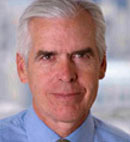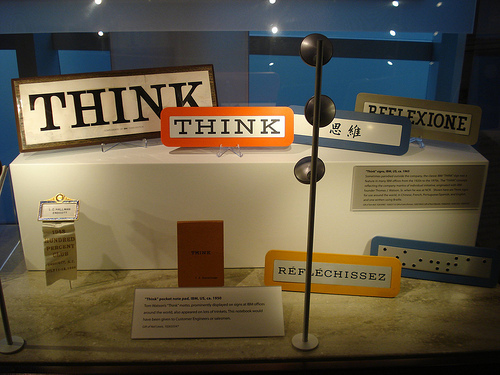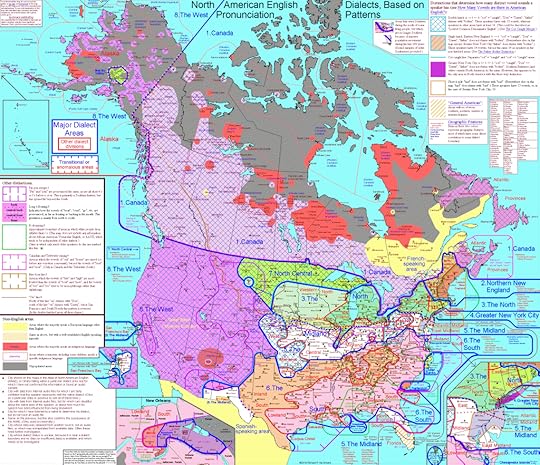Stewart Brand's Blog, page 108
January 21, 2011
Nicolas Berggruen and the Think Long Committee For California
Nicolas Berggruen is known as a bit of an eccentric and often referred to as "the homeless billionare" because of his unique lifestyle – he travels the world in a private jet and lives out of hotels. Financial Times recently interviewed him at one of those hotels and discussed his interest in reshaping the politics and governance of California:
And, having conjured a fortune, he has now a second more ambitious goal: a bold initiative to change the way that western politics and government is conducted. A few years ago, he started attending university courses and became fascinated with the flaws in western government systems. "I have always been very interested in history, so I sat down with a group of intellectuals and wrote a utopian constitution."
He also used $100m of his money to create a think-tank, the Berggruen Institute, which promotes fresh debate about politics and constitutional reform. Then, four months ago, he used $25m to launch a more specific campaign to "save" California, a place where he spends several months each year, usually living at the Peninsula Hotel in Beverly Hills.
The institute is now promoting radical fiscal measures to tackle the state's ballooning debt burden and to implement longer-term structural reforms, under the rubric of the "Think Long Committee for California."
- Gillian Tett, Financial Times
The Think Long Committee for California will consist of 10 or 15 "eminent Californians" who will make recommendations to the governor and the legislature and may potentially propose public ballot initiatives to enact its vision:
From the NBI perspective, good governance involves the responsive, efficient delivery of services to the public by a fiscally responsible government. Above all, it means politics conducted in a spirit of pragmatism that does not sacrifice the long term to short-term special interests.
– Think Long Committee for California







January 19, 2011
Philip K. Howard, "Fixing Broken Government"
Government 4.0
A Summary by Stewart Brand
Americans have made major adjustments to our government before, Howard declared. At the beginning of the 20th century a Progressive era ended strict laissez-faire. The New Deal in the 1930s provided social safety nets. In the 1960s Civil Rights came to the fore. Now we need a fourth big change, because our government has managed to paralyze itself with…
Read the rest of Stewart Brand's Summary here.







January 17, 2011
Revolution: The First 2,000 Years of Computing
The Computer History Museum's newly re-designed main exhibition, Revolution: The First 2,000 Years of Computing, is now open to the public. Starting with the abacus and ending with social networking, the exhibit traces our ongoing attempts to mechanically and digitally keep track of our world. In between the two is a history marked by exponential increases in power, performance and ubiquity. Being the largest collection of computers and computer ephemera in the world, that history is documented in extensive, stunning detail in this exhibition with lots of new supporting materials and documentation to tell the story.
Revolution is laid out in a wandering pathway that encourages you to follow along more or less chronologically, but with enough branching and looping back to make you feel like you're choosing your own adventure and not just moving through a series of individual rooms. During the course of walking through the collection, the space expands along with the growth in applications so that census-tabulators and payroll-calculators dominate the first few areas, giving way to appliance-like mainframes, rocket guidance systems, early storage and software until it explodes into the modern diaspora of music, art, movies, games, robots and artificial intelligence, smartphones and laptops, the web, and social networking. All along the way are original artifacts, recreations, video interviews and documentary clips providing a rich, informed, multimedia story of creative and obsessive geeks' toys and the myriad ways they've changed the world.
The Museum is normally closed on Mondays, but for the Martin Luther King Jr. Day Holiday, they're open from 10am to 5pm.
The slide-show below includes some shots from a visit earlier this week. Don't miss Long Now co-founder Danny Hillis and his Connection Machine!







January 14, 2011
Water Becomes a Global Commodity
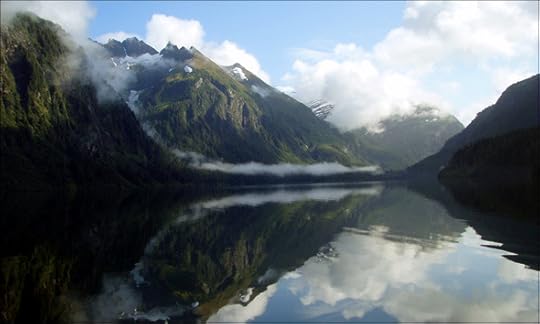
Blue Lake in Sitka, Alaska
Newsweek reports that Sitka, Alaska is looking at selling 3 billion of gallons of water for bottling in Mumbai India shipped via tanker. This will mark one of the first major water transfers of this sort, making water a globally traded commodity. It also brings up some interesting questions around climate change and how will affect population centers. It is said that water always travels uphill towards money, if this deal goes through we will determine if it will also cross oceans toward money.

Mumbai, India







January 13, 2011
Water Becomes a Global Commodity

Blue Lake in Sitka, Alaska
Newsweek reports that Sitka, Alaska is looking at selling 3 billion of gallons of water for bottling in Mumbai India shipped via tanker. This will mark one of the first major water transfers of this sort, making water a globally traded commodity. It also brings up some interesting questions around climate change and how will affect population centers. It is said that water always travels uphill towards money, if this deal goes through we will determine if it will also cross oceans toward money.

Mumbai, India







An Archive Model with Long Term Benefits
On January 9, The Rosetta Project presented a poster at the Linguistic Society of America annual meeting, describing a distributed archive model we've developed and implemented with the Rosetta digital collection. Here is a video describing this model, and some of its long-term benefits:
A pdf of this poster is available for download here (12 MB).
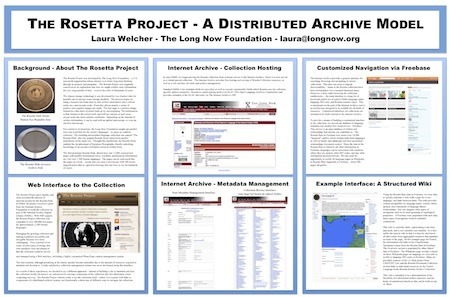







January 12, 2011
North American Dialects On Twitter and YouTube
Using data from the Atlas of North American English (ANAE) by William Labov, Sharon Ash, and Charles Boberg combined with his own research, linguist Rick Aschmann created the detailed map above to show regional dialects throughout North America. One of the coolest features is that he's linked over 600 YouTube videos to the map, so that clicking a region will take you to video clips of (mostly famous) people raised in that area so that you can hear a sample of the dialect.
Researchers at Carnegie Mellon have done some similar research, though they're using social media – Twitter specifically – as the data source, rather than just to illustrate linguistic nuance. Jacob Eisenstein and his colleagues looked at 380,000 geo-tagged tweets recently and explored the geographical dialects represented within. They saw differences in the way people abbreviate words to fit the short medium and the slang terms they used in informal messaging and were able to create a statistical model from the variation they saw that could predict the location of a user to within about 300 miles based on the dialect used.
The existence of Twitter and other informal, microblogging platforms affords a newly accessible, low-cost source of data for linguistics researchers since they don't require labor-intensive in-person interviews to uncover patterns of informal speech:
Studies of regional dialects traditionally have been based primarily on oral interviews, Eisenstein said, noting that written communication often is less reflective of regional influences because writing, even in blogs, tends to be formal and thus homogenized. But Twitter offers a new way of studying regional lexicon, he explained, because tweets are informal and conversational. Furthermore, people who tweet using mobile phones have the option of geotagging their messages with GPS coordinates.
Eisenstein also points out that the identifiable regional variation could be an indicator that the internet is less a force for homogenization than often thought.
The Georgetown University Round Table on Languages and Linguistics later this year will explore many ways in which these, "new worlds of words occasion innovative uses of language and new spaces for constructing identities, forming relationships, and expressing social meanings." (GURT 2011)
So, expect to see plenty more research mining social media and remember to act normal online so you don't throw off the results.







January 11, 2011
Victorian Infographics
These Victorian infographics take a beautiful, hand-drawn approach to the presentation of various geographic and astronomical data. The image above was published in 1854 and compares various mountains and river systems side-by-side.
Don't miss the Tableau de L'Histoire Universelle, which represents nations and empires as rivers flowing through history and plenty more at BibliOdyssey.
(thanks to a new member Marianna!)







Mary Catherine Bateson Ticket Info
The Long Now Foundation's monthly
Seminars About Long-term Thinking

Mary Catherine Bateson on "Live Longer, Think Longer"
TICKETS
Wednesday February 9, 02011 at 7:30pm Cowell Theater at Fort Mason
Long Now Members can reserve 2 seats, join today! • General Tickets $10
About this Seminar:
Decades of Mary Catherine Bateson's work have focused on learning as an ongoing, improvisational act. Teaching cultural anthropology at Harvard, Northeastern and Amherst, heading the Institute for Intercultural Studies, and most recently taking a post as Visiting Scholar at the Center for Aging & Work/Workplace Flexibility, she has long endeavored to bring knowledge unique to individual cultures and constituencies into public discourse.
Her most recent book is Composing a Further Life: The Age of Active Wisdom, an exploration of wisdom and learning in a culture that has only recently, because of extended life-expectancy, come to encompass four simultaneous generations.
Twitter - up to the minute info on tickets and events
Long Now Blog – daily updates on events and ideas
Facebook – stay in touch through our fan page
Long Now Meetups - join one or start your own







January 10, 2011
Long Bet on Peak Travel
One of the miracles of the modern world is our capacity for getting around – hop on a plane, nap a few hours, and you're on the other side of a continent! Technologically enabled, we've embraced this ability with gusto and are currently more mobile a species than ever before. But, according to a pair of Stanford researchers, the industrialized world is mellowing on this trend a bit. They claim that travel in several countries may have peaked earlier this decade:
A study of eight industrialized countries, including the United States, shows that seemingly inexorable trends — ever more people, more cars and more driving — came to a halt in the early years of the 21st century, well before the recent escalation in fuel prices. It could be a sign, researchers said, that the demand for travel and the demand for car ownership in those countries has reached a saturation point.
A Long Bet placed in 02005 hinted at this potential, though it imagined a more dire mechanism: peak oil. While the necessary statistics to certify Long Bet 197 won't be published for some time yet, they'll come from the U.S. Bureau of Transportation Statistics and tell us whether highway vehicle miles traveled in the U.S. for 02010 exceeded those of 02005. The Bet is that they'll actually be lower – essentially that Americans collectively drove less in 02010 than in 02005.
The scenario imagined by predictor Daniel Simon in 02005 was that an energy crisis brought on by peak oil production would push up the cost of personal motor vehicle travel enough to halt or reverse its growth. Glen Raphael was doubtful enough to put up the money for a Bet and explained he expected growth to continue. Read their full arguments Long Bets.
According to the BTS table they provided as a reference for adjudication, total vehicle miles travelled in 02005 were 2,989,430. The most recent year published on that table is 02008 and it checks in at 2,973,509 – almost 20,000 miles fewer. So, we can't finalize the Bet as of yet, but the data we've got is in line with the Stanford study as well as Simon's prediction, despite a seemingly more mundane overall picture.
Check back in a year or two for the exciting conclusion! (Also, if you or someone you know works at BTS, let us know if we've missed more recent numbers.)







Stewart Brand's Blog
- Stewart Brand's profile
- 291 followers



